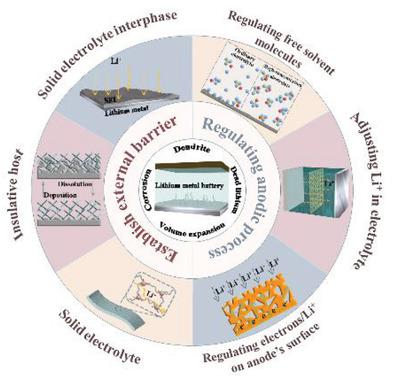Our official English website, www.x-mol.net, welcomes your
feedback! (Note: you will need to create a separate account there.)
Confronting the Challenges in Lithium Anodes for Lithium Metal Batteries
Advanced Science ( IF 14.3 ) Pub Date : 2021-07-01 , DOI: 10.1002/advs.202101111 Qingyu Wang 1 , Bin Liu 1 , Yuanhao Shen 1 , Jingkun Wu 1 , Zequan Zhao 1 , Cheng Zhong 1, 2 , Wenbin Hu 1, 2
Advanced Science ( IF 14.3 ) Pub Date : 2021-07-01 , DOI: 10.1002/advs.202101111 Qingyu Wang 1 , Bin Liu 1 , Yuanhao Shen 1 , Jingkun Wu 1 , Zequan Zhao 1 , Cheng Zhong 1, 2 , Wenbin Hu 1, 2
Affiliation

|
With the low redox potential of −3.04 V (vs SHE) and ultrahigh theoretical capacity of 3862 mAh g−1, lithium metal has been considered as promising anode material. However, lithium metal battery has ever suffered a trough in the past few decades due to its safety issues. Over the years, the limited energy density of the lithium-ion battery cannot meet the growing demands of the advanced energy storage devices. Therefore, lithium metal anodes receive renewed attention, which have the potential to achieve high-energy batteries. In this review, the history of the lithium anode is reviewed first. Then the failure mechanism of the lithium anode is analyzed, including dendrite, dead lithium, corrosion, and volume expansion of the lithium anode. Further, the strategies to alleviate the lithium anode issues in recent years are discussed emphatically. Eventually, remaining challenges of these strategies and possible research directions of lithium-anode modification are presented to inspire innovation of lithium anode.
中文翻译:

应对锂金属电池锂负极的挑战
锂金属具有-3.04 V(vs SHE)的低氧化还原电位和3862 mAh g -1的超高理论容量,被认为是有前途的负极材料。然而,锂金属电池由于安全问题,在过去几十年里曾遭遇低谷。多年来,锂离子电池有限的能量密度无法满足先进储能设备不断增长的需求。因此,锂金属负极重新受到关注,具有实现高能电池的潜力。在这篇综述中,首先回顾一下锂负极的历史。然后分析了锂负极的失效机理,包括枝晶、死锂、腐蚀、锂负极体积膨胀等。此外,还重点讨论了近年来缓解锂负极问题的策略。最后,提出了这些策略的剩余挑战和锂负极改性可能的研究方向,以激发锂负极的创新。
更新日期:2021-09-09
中文翻译:

应对锂金属电池锂负极的挑战
锂金属具有-3.04 V(vs SHE)的低氧化还原电位和3862 mAh g -1的超高理论容量,被认为是有前途的负极材料。然而,锂金属电池由于安全问题,在过去几十年里曾遭遇低谷。多年来,锂离子电池有限的能量密度无法满足先进储能设备不断增长的需求。因此,锂金属负极重新受到关注,具有实现高能电池的潜力。在这篇综述中,首先回顾一下锂负极的历史。然后分析了锂负极的失效机理,包括枝晶、死锂、腐蚀、锂负极体积膨胀等。此外,还重点讨论了近年来缓解锂负极问题的策略。最后,提出了这些策略的剩余挑战和锂负极改性可能的研究方向,以激发锂负极的创新。











































 京公网安备 11010802027423号
京公网安备 11010802027423号